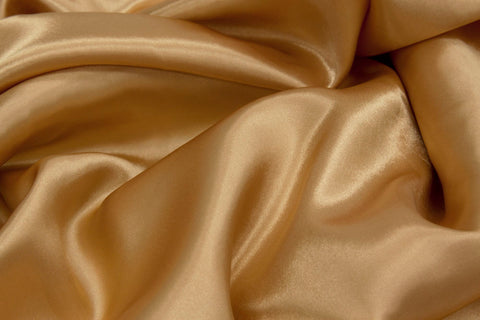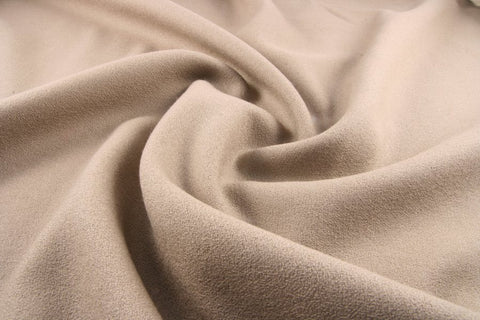Fabric Glossary

Fabric Glossary / Fabric Dictionary
0 A B C D E F G H I J K L M N O P Q R S T U V W Y Z

Take a look at our comprehensive fabric glossary which provides an overview of all our selection of fabrics. This page offers in-depth descriptions of our whole lineup of fabrics, from exquisite wool fabrics, silk, cotton, and polyester fabrics to comfy and fashionable faux fur fabrics of different designs and styles.
Whether to make upscale designer outfits, accentuated home decor projects, or creative arts and crafts functions, you can select from our wide range of fabrics to suit any project. iFabric is dedicated to providing our esteemed customers quality and affordable fabrics for all your clothing and decorative needs. Don’t hesitate to contact us for any information.
A
Absorbency:
The capability of a material to absorb moisture. For example, terrycloth is popular for towels and bath robes because it is a very absorbent fabric. Microfiber fabrics also provide high absorbency.
Acetate:
A synthetic fiber composed of cellulose (made from wood pulp and/or cotton linters) and acetic acid. The acid is treated by a special process to harden it into fibers. Acetate fabric is lustrous and crisp. It is frequently used for linings, but it tends to be easily stained by perspiration. Acetate material should be sewn in the same way as silk crepe de chine.
Acrylic:
A synthetic fiber known for its softness and hypo-allergenic properties. Acrylic resists wrinkles and acrylic fabric often used for blankets, because it is soft and machine washable. This fabric is practical and durable, but it does tend to pill. It should be sewn in the same way as wool flannel.
Alpaca:
A domesticated small llama prized for its wool. Alpaca fiber is woven into a warm, soft cloth. It is suitable for jackets, coats, capes, wraps, and ponchos.
Amy Butler Fabrics:
Cotton print fabrics designed by Amy Butler. Butler is known for her fresh innovative cotton prints variously inspired by Art deco, Oriental prints and 1960s' florals. These designs are ideal for quilts, pillows, garments, tote bags, and other accessories. They make delightful dresses for both women and children. Easy to sew and easy to care for, Amy Butler fabrics are prized by expert sewers and quilters and are suitable for beginning sewers.
Angora:
Fiber from the Angora goat. Angora is used to make mohair, a fuzzy fabric. It should not be confused with the fur of the Angora rabbit which is also woven into a yarn and used to knit sweaters.
Antique Grain Sacks:
A used cloth sack used to store grain and generally made of burlap. Variously called burlap sacks and gunny sacks, bags to hold most grains must be tightly woven. Antique grain sacks may be actual antiques several decades old, but contemporary reproductions of grain sacks are also sometimes called antique grain sacks. Genuine grain sacks often have advertisements printed on them. They can be used for decorating with a country or nostalgic theme.
Antique Satin
A reversible satin weave fabric which is also known as satin back shantung. Antique satin is any of the five or eight harness satin weave fabric with two distinct sides. The technical side has satin floats while the back features unevenly spun or slub-filling yarns to mimic silks from the 17th and 18th centuries.
Antique satin is perfect for drapery and apparels such as evening wear, lingerie, and blouses. The fabric has a dull and dense texture and can get damaged quite easily. For this reason, the fabric should only be cleaned by a fabric specialist to avoid damage. The material can be made with a variety of fibers including a combination of acetate, rayon, and silk.
Antique satin came to the market in the 1950 and had grown ever since to become a mainstay of the drapery industry.
Argyle:
Refers to a diamond-shape pattern woven into a material. Argyle patterns are most often used in knitted garments such as sweaters.
B
Bamboo Fabric:
Fabric made of bamboo grass pulp. It is an environmentally friendly product. Durable and lightweight, bamboo fabric is naturally slightly antibacterial. It is very absorbent and wicks moisture away from the body.
Barkcloth
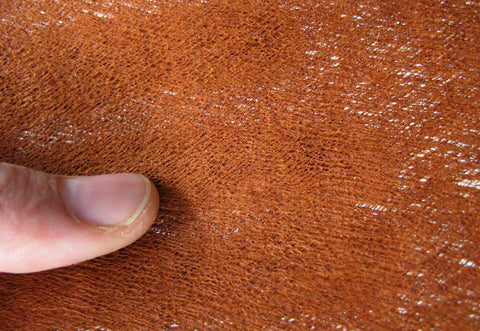
A soft textured woven fabric made of thickly woven cotton fibers. Barkcloth got its name due to its rough surface which resembles the tree bark. During the 30s-40s down to the 60s, barkcloth featured prominently in interior decoration and was used extensively in home furnishings including drapery, curtains, upholstery, slipcovers among others. The fabric usually has prints of leaves, florals, vines, abstracts, and many other themes which used to be very popular in the 50s.
The barkcloth has evolved over the years, and there are now different designs and variations of the fabric including the soft textured American barkcloth among others.
What originally started as a fabric made from the inner barks of native trees is now a versatile fabric made from various synthetic materials such as rayon, metallic fiber, and others.
Basket Weave
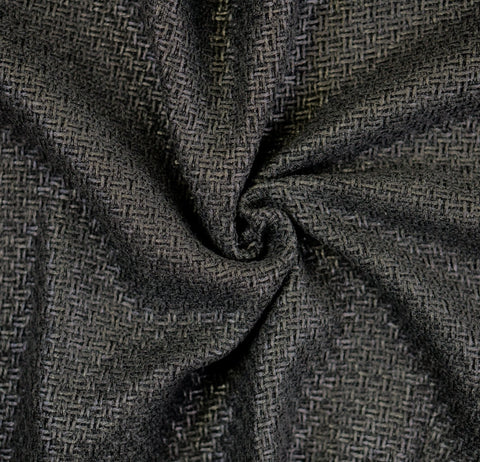
A unique method of weaving that produces fabric that looks like a basketwork with interwoven fibers. The technique is popular among several textile arts such as weaving, knitting, and knot making.
The basket weave technique involves making multiple vertical and horizontal strands which create a square pattern similar to the structure of woven baskets. The method is commonly used in home decor projects.
Batik

Originally from Indonesia, Batik is a technique for dyeing fabric that uses wax resist molds to create complex designs and patterns. To make Batik, the artisan pours wax on a piece of fabric, which is usually cotton and then leaves the wax to solidify into the shape of the intended design, after which the fabric is dyed and the wax removed, leaving the parts covered by the wax in the original colors of the cloth.
To create an elaborate Batik design, the artisan only needs to repeat the waxing and dyeing process, while dyes seeping through cracks in the wax help create the distinct veined Batik look.
Batik is now widely used in different parts of the world to create unique clothes but the Indonesian Batik stands tall above all others.
Batiste
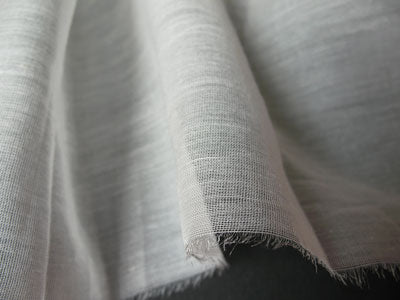
Batiste is an exceptionally soft, semi-sheer, lightweight, plain weave opaque fabric. Batiste is usually made of wool, cotton, polyester or a combination of different fabrics. Perfect for lingerie, handkerchiefs, baby clothes, heirlooms and lining for high-quality clothing.
Developed since the 1400s, Batiste has its origins in France and the opaque nature is due to the fabric not being treated with an acid finish.
Battenberg:
A machine or hand made renaissance lace made from linen thread and linen tape or braid. Battenberg lace is made in many designs.
Bedford Cord:
A cotton cloth which resembles corduroy with horizontal ridges. The ridges of Bedford cord are faint by comparison to the distinctive wales of corduroy. This durable fabric is suitable for work clothes and upholstery. It should be sewn in the same manner as corduroy.
Boiled Wool
Felted knitted wool, it offers the flexibility of a knit with great warmth. Create your own by washing double the needed amount of 100% wool jersey in hot water and drying in a hot dryer. Expect 50% shrinkage. Appropriate for jackets, vests and stuffed animals.
Bengaline Fabric:
A material made with a distinctive crosswise rib. Bengaline fabric can be nylon, cotton, rayon, wool, or a blend.
Birdcage Netting:
A large gauge netting fabric used for hat veils which are worn over the face. Birdcage netting is also called Russian netting. The netting may come simply over the eyes or it may veil the nose and mouth as well. The wearer is given the appearance of being in a birdcage. Veiled hats are popular for weddings and can be made in variety of styles, ranging from small pillbox hats to large-brim picture hats. Russian or Birdcage netting is available in many colors and in dotted versions.
Birdseye Fabric:
Woven cotton fabric with a distinct weave that is lightweight and absorbent. Because of its softness and absorbency, Birdseye fabric is popular for cloth diapers. It keeps the baby's skin dry and comfortable. It is sold by the 27" width; the perfect width to make 27" square diapers. Soft birdseye fabric makes ideal utility towels. Cut it to 27" square or an 18" by 27" piece and hem. It is perfect for polishing delicate surfaces as well.
Black Batting:
Black-colored polyester padding for quilts. Batting, is traditionally a white or cream color, but black batting is ideal when you want to enhance the richness of the quilt's colors. Black batting is produced by Quilter's Dream, one of the top batting manufacturers. Quilter's Dream Midnight Black Request Batting and Quilter's Dream Midnight Select Batting are made of fine quality polyester microfibers without resins, glues, or other chemicals using a unique needlepunch process which gives the products the breathability and softness of natural fiber batting. Stitching can be placed several inches apart on this batting which resists shifting, bunching, and bearding.
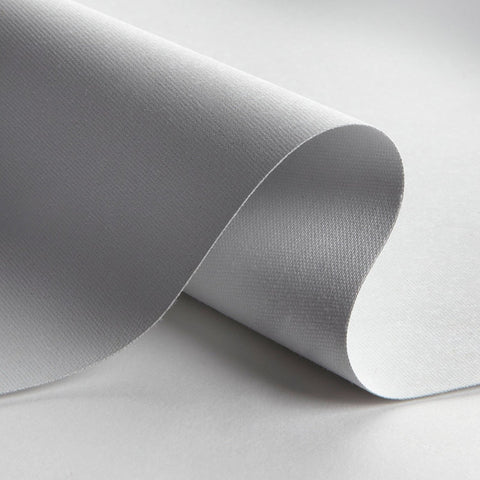
A thick fabric with two or three layers of fabric that helps to block out light coming from the exterior of windows. Mostly used for drapery, blackout fabric is available in 2-pass with two layers of foam and the 3-pass with three foam layers that effectively block out the light completely.
In addition to helping block out light, blackout fabric, especially the 3-pass variant can also be used for sound-dampening and insulation purposes. Blackout fabrics are used extensively in hospitals and hotels.
Boucle

A woven or knit fabric with loops that form an uneven, textured surface at intervals which creates a nubby appearance. Coined from the French word for curled, Boucle can be made by hand or machine and has a knotted and curly surface with a soft and bouncy feel.
The fabric's nubby surface makes it ideal for use in coats, vests, and sweaters.
Broadcloth

A thick plain weave woolen cloth traditionally made of tightly woven wool or a combination of cotton and wool. It features a soft, lustrous and heavier build with a crosswise rib. Due to its sturdy and tightly woven texture, broadcloth is highly weather-resistant, long-lasting, and hardy enough to use without hemming the edges.
Most common uses include shirt making, quilting, as well as interior decor and luxury car interior finishes. .
Braemore Fabric:
A division of P. Kaufmann Fabrics, a leading manufacturer of upholstery, drapery, and wall covering fabric. Braemore Fabric produces top quality fabrics available in numerous styles suitable for contemporary and traditional decors and every room in the home. The cotton prints range from large florals to romantic old fashioned toile scenes to contemporary boating and rodeo motifs, stylish paisleys, bright stripes, and geometric patterns, dotted material, and more. This manufacturer also features many solid-colored, textured upholstery and drapery fabrics in a variety of fibers.
Brocade
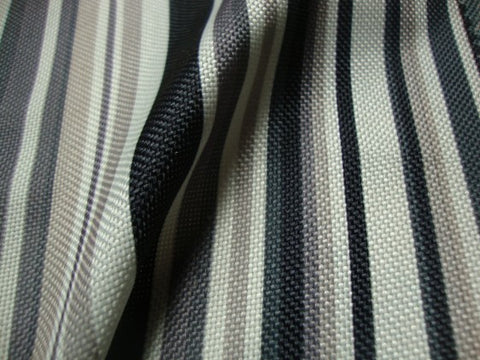
A type of elaborately decorated, thick, and dense material made with a satin weave and Jacquard loom, usually with a raised floral pattern. From the Italian broccato which means embossed cloth, Brocade is traditionally made with rayon, silk, or nylon, and features a strong Oriental appearance.
Brocade is most commonly used in home decor, upholstery, draperies, women's wear, formal clothing, evening wear, costumes, and accessories.
Bridal Fabric:
Any fabric suitable for wedding dresses, bridesmaid dresses, flower girl dresses, and mother of the bride dresses. Traditional bridal fabrics include satin, silk, crepe de chine, chiffon, georgette, organza, tulle, and lace. Laces include both handmade and machine-made varieties. White and ivory are the classic wedding gown colors, but are not the only choice. Some brides choose a dress in a non-traditional color while others choose to incorporate color into their white or ivory dress. Bridesmaid, flower girl, and mother of the bride dresses can be any color desired.
Bridal Satin Fabric:
A fabric with a high sheen made of either silk or polyester. Bridal satin fabric is the most popular wedding dress fabric. Traditionally made of silk and worn only by the wealthy, today high quality polyester satin is luxurious and affordable. Satin is available in various weights and varieties. Crepe back satin is used for garments that require body; it features a satin sheen on the front and a matte crepe back on the reverse. Charmeuse, a glossy soft fabric, is great for flowing fashions which require draping. Habutae is very lightweight with a subtle sheen and is suitable for linings.
Buckram
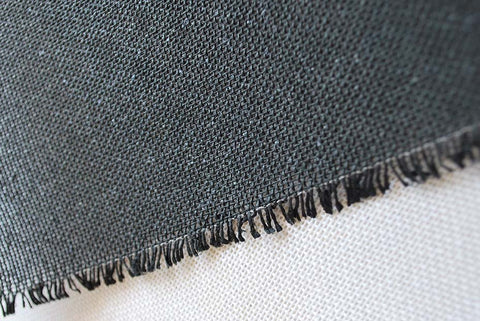
A stiff cotton fabric which is strengthened by soaking in a substance such as pyroxylin to fill in the gaps between the fibers, making it extremely stiff and strong. Buckram is mostly made with cotton which is reinforced with resin and starch but can also be made with linen and horse hair.
There are several varieties of the Buckram fabric, and it is used as the supporting material inside of baseball caps, lady’s' hats, children's hats, doll's hats, bookbinding, handbags, belts, costumes, among others.

A dense woven, heavyweight, plain weave fabric made from the skin of the jute plant and other vegetable fibers such as the sisal. With a strong and coarse texture, burlap or jute is used for decorative and drapery purposes.
It is also used extensively in the packaging of agricultural produce such as cocoa and cashew due to its breathability. Due to its biodegradable nature, burlap is now heavily utilized as an eco-friendly packaging, and it is a favorite of gardeners and farmers as it holds well for transplanting, sandbagging and other agricultural uses.
Burn-Out Velvet:
A velvet fabric with a design created by a special process. The design is created through the application of chemicals to a pattern which burn away part of the velvet, revealing the backing material. Burn-out velvet is suitable for loosely fitting garments and unconstructed items.
C
Calico:
A cotton, tightly woven all-over print fabric. The print is generally a small floral on a contrasting background. Sometimes the term calico is used to refer to any cotton fabric. Calico is great for quilts, dresses especially children’s dresses, aprons, and household accessories such as appliance covers.
Cambric:
Can refer to one of two different fabrics. One is a fine white linen. The other type of cambric is a durable black nylon fabric which is used as a dust cover on the bottom of upholstered furniture.
Camel's Hair:
The under-hair of the camel used to weave a fabric which is similar to cashmere. Camel’s hair fabric has a soft hand and is suitable for jackets and coats.

A strong and highly durable plain-woven fabric made of cotton or linen. Due to its heavy-duty texture, canvas fabric is used extensively for making tents, backpacks, bags, sails, and other projects where you need a strong fabric. Canvas is a top choice of many artists who use it as a painting surface for oil paintings, and it can also be used for fashion accessories, footwear, and so many others.
Canvas can be plain or duck. Duck canvas features a more tightly woven fabric and is the more preferred. Canvas has also found uses as a base fabric for embroidery projects and is the preferred fabric for making tarpaulins, marquees, tents, among others. Check out our impressive collection of duck and plain canvas.
Cashmere:
Fiber from the fleecy undercoat of the Kashmir goat. It is used to produce both knitted and woven fabrics. Cashmere is a soft, luxurious fabric which is used for shawls, sweaters, coats, dresses and suits.
Challis:
Woven fabric of rayon, cotton, or wool, with a somewhat brushed surface. Challis is suitable for dresses and blouses and is available in prints and solids.
Chambray:
Woven fabric generally composed of cotton, but it can be made of silk or other materials. A colored warp and white filling yarns give the fabric its unique look. It comes in different colors, but is traditionally blue. Chambray is used for casual clothes—shirts, skirts, pants, and blouses.
Chalk Cloth

A lightweight fabric made of vinyl or similar materials which can be used like the surface of a chalkboard. An excellent fabric for arts and crafts projects, chalk cloth is an extremely versatile fabric that can be used multiple times and all you have to do after writing on the surface is to wipe off the chalk with a wet sponge or towel and its ready for use again.
Chalk cloth is perfect for tablecloths, posters, decorations, posters, arts and crafts projects, among others. Durable and versatile, chalk cloth can be sewn into different shapes and sizes, decorated with bright-colored chalk and hung on the wall, spread on the table, and so much more. It’s great for signs and banners, party easels, placemats, tablecloth and table runners.
Challis

A lightweight woven fabric made from natural fibers such as wool and silk or synthetic fibers. With an excellent drape and a soft and smooth texture, challis originated in England in 1832.
Now widely used all over the world, challis is an exceptional fabric that is used for blouses, skirts, and dresses. The fabric can feature various designs including geometric, floral, or paisley among others.
Chambray

A plain woven fabric commonly made by combining a colored yarn in the warp and white filling yarns. Traditionally made from cotton or silk, chambray is also made from synthetic fibers and is similar in appearance to denim but has a smoother surface and lighter weight due to its plain and tightly woven texture.
While it commonly features blue color, chambray can also come in many other colors. Perfect for making shirts and light summer apparel such as shorts, tops, skirts, sneakers, dresses, among others.
Chambray is also great for home decor projects such as curtains, tablecloths, pillows, placemats, as well as upholstery, quilting, bedding, and can also be used for fabric covers for journals, napkins, aprons, handbags, notebooks, and so on.
Chenille

Named after the Caterpillar whose fur the yarn resembles, chenille is made from fuzzy yarns which create a soft and fluffy fabric. Originating from 18th century France, Chenille can be made from cotton, silk, rayon as well as manufactured fibers.
An extremely versatile fabric, chenille is suitable for a diverse range of uses including home decor and upholstery projects such as cushions and carpets, bedspreads, shawls, as well as quilting projects.
Chantilly lace
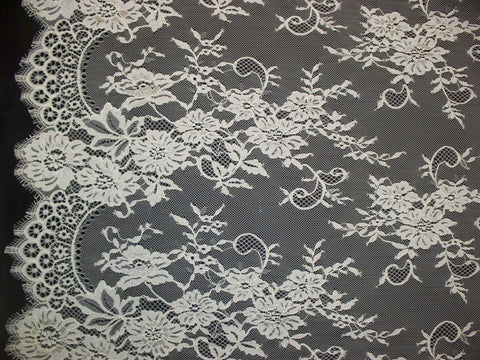
An excellent lace with rich details and abundantly outlined patterns, Chantilly lace, is a handmade bobbin lace named for the French city of Chantilly. Featuring a net background, the Chantilly lace is made by embroidering with thread and ribbon to form extremely detailed floral patterns.
The fabric features areas with dense designs and outlines with heavier threads or cords. Chantilly is traditionally made from silk or linen and is usually in white or black colors. While it was made mostly by hand at inception, there is now high-quality machine-made Chantilly lace that is indistinguishable from the hand-made.
A beautiful fabric, Chantilly is excellent for dresses, shawls, bridals among others.
China Silk
A thin, delicate silk, or polyester known for its breathability; it allows air to circulate through the fabric. This property makes it ideal for linings. Polyester Habutae is also known as China Silk; it is affordable, practical, and perfect for linings. Habutae is available a wide range of colors. In addition to linings, China Silk or Habutae are suitable for luxurious lingerie and thin blouses. Both the silk version and the polyester version can be sewn in the same way.
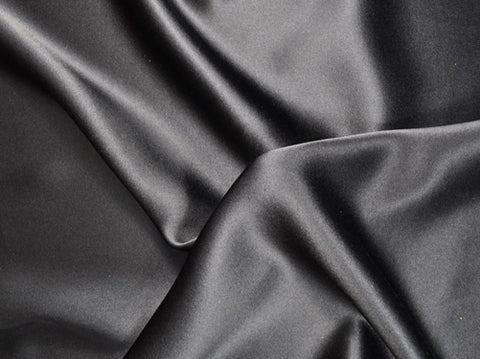
A lightweight satin weave fabric with a brilliant and reflective finish and smooth and fluid drape. Made from silk or manufactured fabrics such as polyester, its used for a wide range of purposes.
Due to its delicate and lustrous feel, charmeuse is widely used for making lingerie, drapery, blouses, binding baby blankets, and slinky evening dresses and gowns.
Charmeuse is also used in men’s clothing as a lining of jackets, ties, slacks, and handkerchiefs. Charmeuse has excellent drape qualities and reflects light in dazzling patterns.
Cheese Cloth
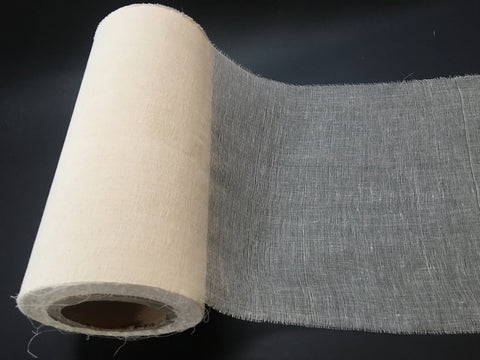
A soft and loose-weave fabric with a porous texture which is mostly used in cooking and cheese making. Featuring a natural off-white color, bleached white, or dyed, cheesecloth comes in different grades of porosity.
Cheesecloth is mainly used to remove whey from the cheese curds and hold the curds together during the process of cheese making. It can also be used for making ghee and tofu, bundling herbs, thickening yogurt, and straining custards and stocks.
In the printing industry, cheesecloth is used for wiping off excess ink from the printing surface and wiping up gum Arabic on lithographic plates. The fabric is also used for making summer shirts in countries such as Pakistan and India among other uses.
Cheesecloth Fabric:
A very porous, loosely woven cotton material. Cheesecloth derives its name from its original purpose. This versatile cloth was originally used to strain the whey from cream during the making of cheese. Today cheesecloth fabric is still used for culinary purposes, such as straining gravies and sauces. It is also used for crafting, especially in paper mâché and can be used as a presscloth. The fabric is available in narrow widths in several grades. The higher numbers indicate a more tightly woven cloth.

A lightweight, plain woven and extremely sheer fabric featuring twisted fibers and a rough feel due to the manufacturing process. Chiffon was traditionally made from silk but is now widely made from manufactured fibers such as nylon and polyester.
Due to its delicate and floating feel, chiffon is used extensively as an overlay in gowns, blouses, loose tops or dresses, scarves, ribbons, and lingerie.
Chintz
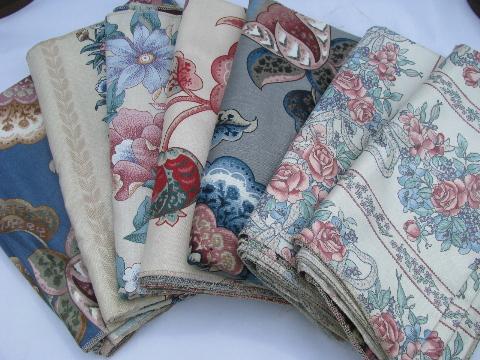
A plain-woven fabric glazed to create a polished look. Originally from India, chintz fabrics feature beautiful floral designs of flowers and various patterns of different colors printed on a plain background.
Chintz can be used for lining and drapes and must be washed by a professional to avoid damaging the glazing.
Corduroy

An extremely hardy fabric traditionally made from cotton or blend of cotton using a cut-pile weave technique. The unique pattern of the fabric or cord is formed by weaving twisted fibers parallel to one another.
The type of corduroy depends on the number of ribs or wales per inch of the fabric which can range from 3 ribs per inch to 21 ribs per inch.
Corduroy is mainly used for pants, jackets, shirts, and skirts.
Cornice Padding:
Thin upholstery foam which is sold by the sheet and is very flexible. A cornice is a decorative cover for curtain and drapery rods and the top of window blinds. It can add drama and a finishing touch to window treatments. Cornices may be painted or they may be covered with fabric. Cornice padding is placed underneath the fabric for a smooth, finished look. It is affordable and easy to use.
Crepe
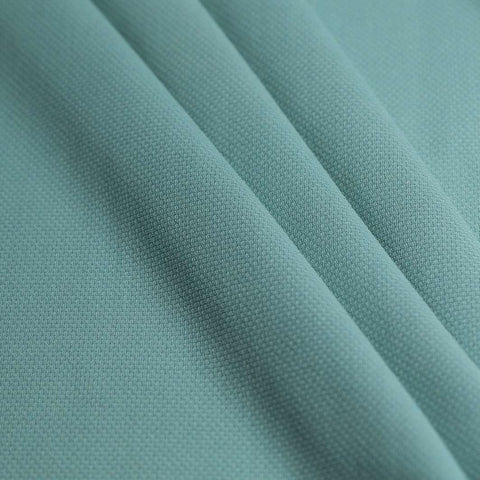
A type of fine, gauzelike fabric made from wool, silk or manufactured fiber fabric that is twisted to form a distinctly textured surface. Crepe is available in various forms and weights depending on its uses and origin. Lightweight crepe is used for making skirts, blouses, and dresses while medium and heavyweight crepe is great for classic attires.
Cotton:
A product of the cotton plant. The most widely used natural fiber in textile manufacturing, cotton has been used for centuries to produce lightweight, comfortable fabric. Cotton allows the skin to breath. The fiber can be used by itself or blended with other fibers to make soft, durable cloth. Examples of fabrics which are cotton or cotton blends include: batiste, birdseye, broadcloth, calico, lawn, seersucker, terrycloth, and ticking.
Crocheted Fabric:
Fabric made by hand using a hook. It comes in innumerable designs. The look of crocheted fabric is sometimes produced by a machine technique, but anyone familiar with hand crotchet can detect the difference between the two. Crocheted fabric is used for yokes, collars, and inserts, as well as sweaters and other garments.
Crewel:
The art of embroidery with yarn. Crewel fabrics are a luxurious touch for draperies and upholsteries. The embroidered motifs are generally flowers and foliage. These fabrics have traditionally been handmade in India. Modern textile weaving techniques have produced “crewel” looking designs without the use of embroidery.
Crinkle Taffeta:
A polyester, silk, or nylon fabric with a distinct crinkled texture. Taffeta is a classic fabric known for its crispness and subtle sheen. Crinkle taffeta is a form of the material with a unique texture, rather than the smooth surface of the traditional fabric. It is suitable for bridal wear and evening wear and is available in variety of colors. This fabric should be sewn and cared for in the same way as standard taffeta.
Crepe de Chine
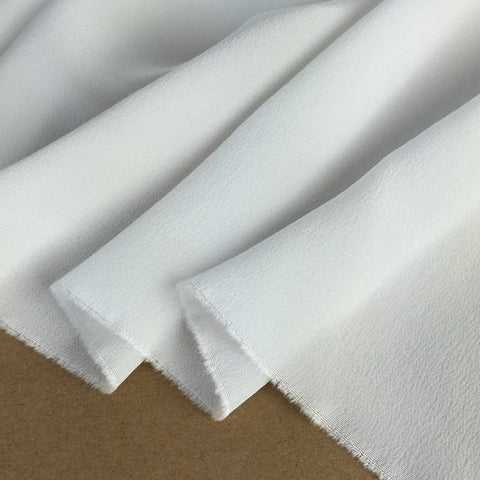
A crimpy or crinkled surface plain weave fabric with a fine, lightweight texture made from silk, cotton or synthetic fiber. Has an extremely smooth feel and subtle reflection.

A type of satin fabric featuring a crinkled texture of crepe on the wrong side and a smooth, lustrous finish on the right side. The fabric is used mainly for constructing special occasion garments.
Chite:
Rare painted linens done in a style which came from Chitta, India in the seventeenth century. Chite fabric is luxurious and unique.
Clear Vinyl Fabric:
Vinyl material which is translucent. It is available in various weights, ranging from 6 gauge to 60 gauge. It is durable and versatile. Clear vinyl fabric can be used to cover cloth tablecloths, protecting them from spills and allowing their beauty to show through. It is also used to cover furniture and books. This clear material can be used in various crafts; for example, it can be used to make pockets on a hanging jewelry or sewing caddy allowing the items inside to be seen. Heavier translucent vinyl can be used to make shoe caddies.
Cordura Fabric:
A very heavyweight nylon fabric coated with urethane. Cordura fabric is abrasion resistant and waterproof. It resists tears and stains. This extremely durable fabric is ideal for outdoor gear such as raincoats and backpacks. The weight of this fabric is measured in deniers. The higher the denier count, the stronger the fabric. A denier count of 1000 is suitable for garments and projects that will be subject to hard use such as tents. Cordura of this weight is available in a variety of colors and in camouflage.
D
Damask

A dense reversible fabric typically made from cotton, linen, silk, wool, or manufactured fibers. Originally from Damascus in Syria, Damask is made using a satin weave to form an opulent pattern. While it has a glossy finish like Jacquard, Damask is made in one color. Modern damasks are made on computerized Jacquard looms in single colors, and can come with patterns of fruits and flowers among others.
Incredibly versatile, Damask is widely used in the fashion industry due to its luxurious finish. It is also used extensively for draperies, table linens, curtains, and home decor projects.
Denier

A measure of the linear mass density of a fabric's weave. One denier is the mass of 9000 meters of fabric in grams. The term was borrowed from French and is one of several units of measuring the density of the fiber in fabrics. The lower the denier value of fabric, the more lightweight the fabric.
Decorator Fabric:
Fabric used for upholstery, draperies, and wall coverings. An extraordinary variety of decorator fabric is available to modern consumers. Braemore, Covington, P. Kaufmann, and Robert Allen are among the leading lines of décor fabric. Some interior design fabrics are suitable for either upholstery or draperies, but many are designed for a specific purpose. Décor fabric is available in virtually any fiber imaginable. Woven cotton prints and solids are popular. Polyester, viscose, nylon, and rayon are other fibers used to create durable interior decorating fabrics. Prints range from floral to scenic to novelty, along with geometric designs. Weaves include plain and textured.
Denim

A twill weave cotton fabric made with different colored yarns in the warp and the weft. Due to the twill construction, one color predominates on the fabric surface. Suitable for pants, jackets and skirts. Pre-wash and dry 100% cotton denim at least twice to eliminate shrinkage and color bleeding.
Drill
A twill weave, warp-faced fabric with a diagonal bias. Drill is available in medium and heavy weights. This cotton fabric is strong and durable. The medium weight is used for shirts, blouses, martial arts uniforms, work clothes, and play clothes. The heavy weight is for sails.
Dobby
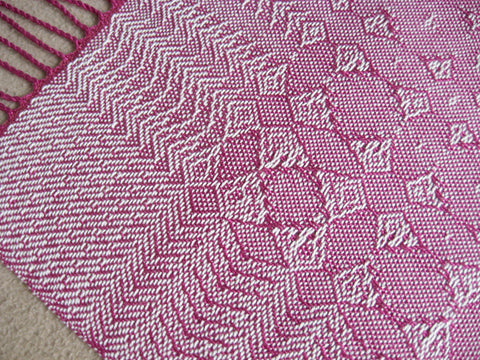
A decorative weave fabric with a characteristic pattern of small geometric figures and extra texture woven into the fabric. Dobby is woven on a dobby loom using threads of the same color or different colors, especially satin threads. Dobby fabric is used to make Polo shirts.
Dotted Swiss

A lightweight cotton or cotton blend fabric embellished with small dots in a flock-like pattern which is either woven into the fabric or printed on the surface. Also known as Swiss dot, Dotted Swiss originated in Switzerland in the 18th century and is used for baby clothes, blouses, dresses, wedding dresses, and curtains.
Doeskin
Fabric with a brushed low nap that runs in one direction. Doeskin is soft and suede-like. It is ideal for pants, full skirts, and tops.
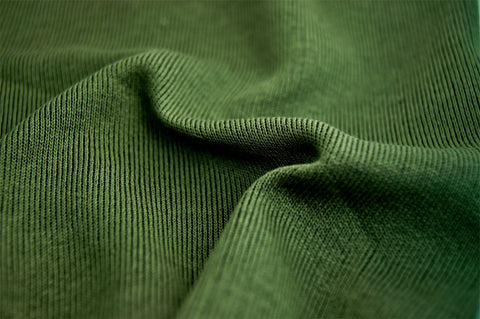
A dense fabric in which two layers of loops are woven together to form an inseparable knit. Double knit is made using a double knit machine which features two complete sets of needles that knit the two fabrics simultaneously. The name of the fabric comes from the process of making it; double knitting.
Down:
The soft, small underfeathers of birds. Down has long been used for pillows and quilts because it provides padding and thermo insulation. It is used to pad jackets and sleeping bags as well. Most commercial down comes from geese or ducks.
Duck
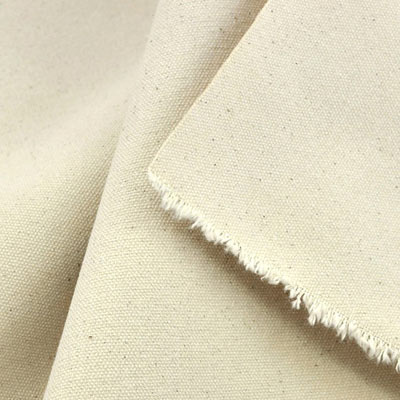
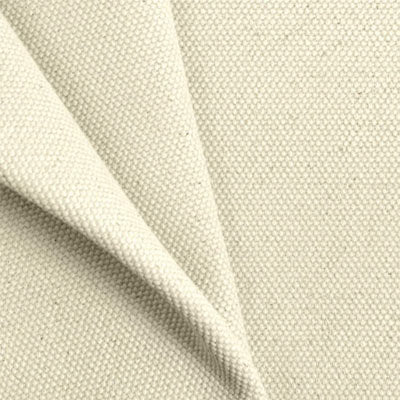
A heavy, plain weave fabric traditionally made of cotton that is resistant to the elements. Also known as duck cloth, duck is a type of canvas but has a tighter weave, which makes it more durable than plain canvas. Duck is widely used for making tarps, outdoor coverings, home decor fabrics, painting canvasses, tents, sandbags, and even sneakers.
Dupioni
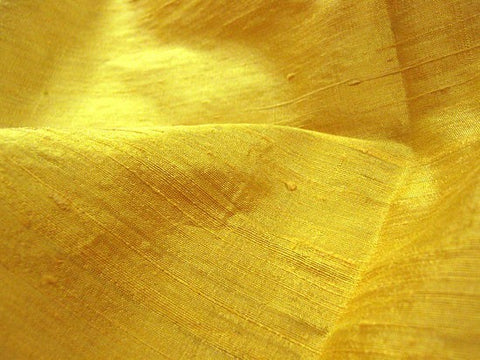
A crisp, plain woven silk fabric made from the uneven thread reeled from the yarn of two silkworms that have nested together and a fine thread in the warp, resulting in a piece of fabric with irregular slubs and a highly-lustrous finish.
Also known as dupion or dupioni silk, this beautiful fabric is excellent for formal and bridal wears, fitted blouses and dresses, jackets, flat-front trousers, upholstery, and even home decor. Dupion is a choice fabric for weddings in India.
E
Elasticity:
Refers to the capability of a fabric or fiber to return to its original state after being stretched. Double knits and spandex fabrics have high elasticity.
Embossing:
A process in which heated rollers are used to produce a design in fabrics. Embossing produces raised designs.
Embroidery:
Embellishment of material with thread, yarn or ribbon sewn to produce a design. There are numerous hand embroidery stitches; the most popular are satin, outline, and cross-stitch. Machine embroidery uses primarily satin stitches which produce a solid-looking design.
Erosion Cloth:
Biodegradable cloth used to prevent erosion. Special erosion cloth is a netlike fabric commonly made of jute, a natural plant fiber, which eventually disintegrates nourishing the soil. It is more effective than many other erosion control methods. The tough net cloth stabilizes slopes and controls erosion by trapping soil particles and keeping them in place. Jute burlap and burlap bags can also be used as erosion cloth. Jute erosion cloth is inexpensive and easy to install.
Erosion Control Matting:
Another name for erosion cloth. Erosion control matting is a netlike cloth generally made of jute, a biodegradable plant fiber. It is spread out and pinned down to stabilize soil, especially on slopes. This method keeps particles of soil in place. It is effective and affordable. The netting prevents the soil from being blown or washed away. Burlap and burlap bags which are also made of jute are often used as erosion control fabrics.
Eva-Dri Foam:
rand of upholstery foam which dries quickly. Upholsterer's foam which is used for seat and back cushions and to pad furniture arms, is often used for patio furniture and marine use. Eva Dri foam is especially made for outdoor use. It is constructed with open cells which let liquid flow through and allow humidity to quickly evaporate. This premium foam for outdoor use comes in thicknesses ranging from 1" to 6" and in several different widths and lengths. The 118" length can make used as a single cushion for a bench or love seat or can be cut into multiple cushions.
EZ-Dri Foam:
A brand of upholstery foam which is mold and mildew resistant and dries easily. Ez Dri foam is designed for use on patio furniture and as boat seating. Its open large pores allow water to quickly drain and evaporate. It resists household chemicals and pollution although chlorine bleach will discolor it. This premium outdoor foam has a fungicidal additive which helps prevent stains and odor from fungus and mildew. It comes in many thicknesses ranging from 1” to 6” and several lengths and widths. There is an appropriate size for most uses and the foam can be cut to size if needed.
Eyelet

A fabric with patterned cutouts, featuring embroidered stitches at the edges for design and to prevent the fabric from raveling.
F
Faille

A shiny, tightly woven fabric made from silk, cotton, rayon, and other manufactured fibers. It features fine ribs in the weft. It originated in France in the earlier part of the 19th century.
Fat Quarter:
A piece of fabric approximately 18” x 22”. It made by cutting a half yard of fabric in half vertically. Fat quarters are sold for quilts. They allow larger pieces and blocks to be cut from the piece than if the standard quarter yard of fabric (9” x 44”) was used. They also allow more colors and prints to be economically included in the quilt.
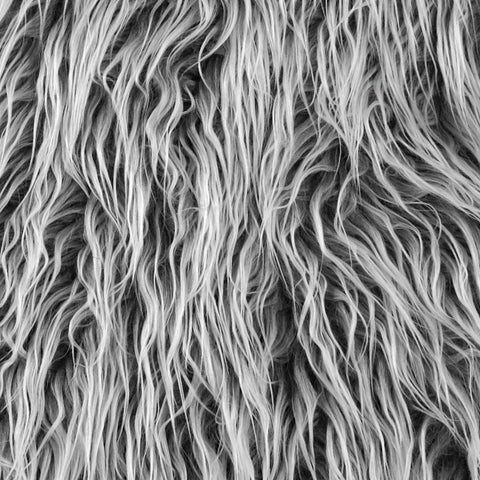
Any fabric designed to mimic the look and feel of fur. Also known as fake fur and fun fur, faux fur is made from synthetic fibers or cellulose and is used to make a part of a piece of clothing.
Faux fur grew popular due to the efforts of animal rights activists to protect the rights of animals used to make furs and the impact of the practice on the environment.
Faux fur is used for a wide range of purposes including every purpose served by real fur, fashion accessories, home decor, arts and crafts, costumes, photography backdrops, and so much more. Faux fur continues to grow in popularity as mainstream fashion houses continue to use it in their designs.
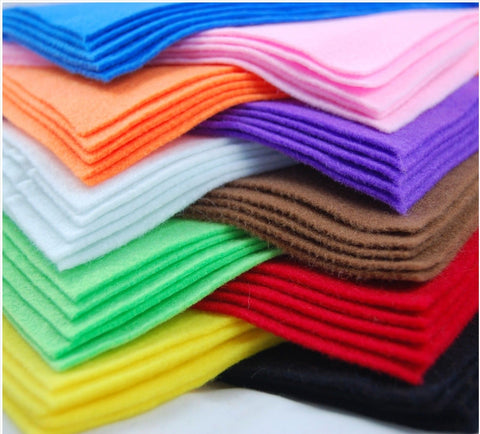
A sturdy, non-weave fabric made by compacting, matting, and condensing fabric such as wool, hair, fur or a blend of natural and manufactured fibers using heat, pressure, and moisture to create an extremely durable and compact fabric.
Felt has a wide range of applications and can be used to make tents and arts and craft projects. It is also extensively used in casinos, automotive industries, home constructions, musical instruments, and gun wads.
Felt is used in industry to pad moving machine parts and to dampen sound and vibration. This durable fabric is also used in fashion for making hats and lining boots.
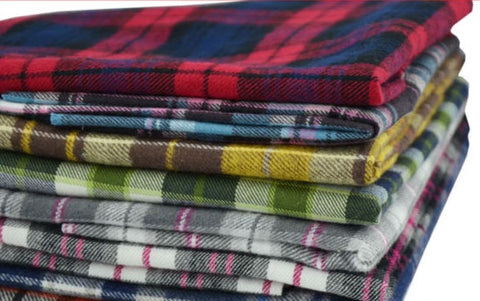
A soft woven fabric usually brushed on one or both sides for extra softness. It is made from cotton, wool, or manufactured fiber.
Flannel is mostly used to construct shirts, sleepwear, bed sheets, blankets, and tartan clothing.
Flax:
Plant which is processed to make linen fiber. Linen is a cool comfortable fabric used for garments, sheets, draperies, tablecloths, towels, and upholstery. It is two to three times stronger than cotton.
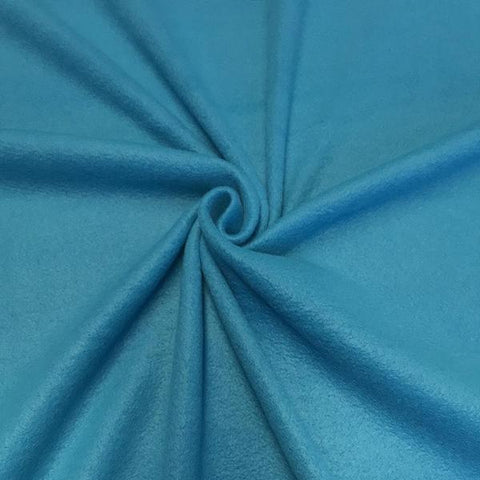
A mostly 100 percent wool or manufactured fiber knit fabric with a long, soft pile. Fleece offers good insulation while being lightweight. The term also refers to shaving all the wool of a sheep at once.
Flocked

A flocked fabric features a velveteen design on its surface to add texture and to increase its value regarding color, appearance, aesthetics, and feel. A fabric may also be flocked to reduce its reflectivity, increase or decrease friction to improve grip and reduce slip or increase its insulation properties.
Flocking is mostly used for apparel and home decor fabrics.
Foil
Material placed under another fabric to give additional brilliance or color. Foil is used for novelty fabrics.
Foulard:
Woven twill fabric which has a small overall printed pattern against a solid backdrop. Polyester, acetate, or silk are used alone or in combination to make this material. Foulard is frequently used for men’s ties and ties are sometimes referred to as foulards.
French Terry Knit
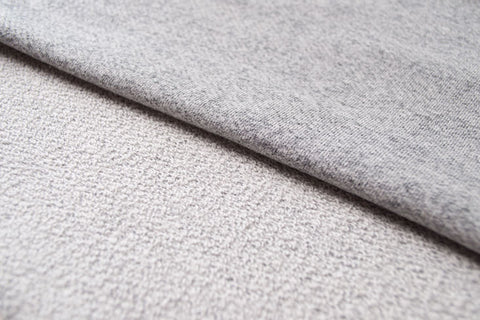
A soft knit fabric featuring soft piles of yarn and loops on the back and a smooth, surface. French terry knit is lightweight, absorbent and extremely moisture-friendly.
French terry knit is mostly made from cotton or a combination of cotton and rayon, lycra, spandex, or polyester.
French terry knit is perfect for tops such as sweatshirts, hoodies, crewnecks, loungewear, pants, and baby items.
G
Gabardine
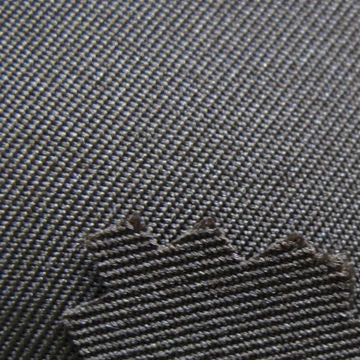
Gabardine A sturdy, tight, wrinkle-free twill-woven fabric with diagonal ribbing. Gabardine is mostly made from worsted wool, but cotton and manufactured fibers or a combination of fibers are also used to make the tough fabric. The fabric is woven as a regular or warp-faced steep twill and features a prominent diagonal rib on the face while the back has a smooth surface.
Gabardine is perfect for making suits, trousers, overcoats, uniforms, windbreakers among others. High-end fashion designers also use gabardine for making pocket linings to make them hole-free. Thomas Burberry, the founder of the English fashion house Burberry invented Gabardine in 1879.
Gauze

A sheer, open-weave, translucent fabric with a weave structure in which pairs of weft yarns cross each other before and after each warp yarn to keep them firm and increase the fabric's stability.
Gauze has been around since Medieval times and is thought to have originated from present-day Gaza, Palestine, from where it got its name. The fabric is made from different fibers depending on the intended use.
Gauze used for clothing is often made from silk, cotton, or synthetic fibers and is excellent for making dresses, blouses, and curtains among others. Gauze is also used in medicine for making gauze sponges used for medical dressing. It is also used in the theatre and film industry as well as in bookbinding for book covers.

A sheer, lightweight, drapery woven crepe fabric with a dull finish made from highly twisted yarns to create a pebbly structure.
Named after the French Dressmaker Georgette de la Plane, Georgette features solid colors and prints. While it resembles chiffon, georgette is less shiny and springier. It is suitable for blouses, flowing dresses, gowns, trimmings, and saris.
Georgette
A semi-sheer or sheer woven fabric with a slight pebble texture. It is made from silk or polyester. Georgette fabric is suitable for flowing dresses, inserts, and blouses. It makes lovely cap sleeves.

A medium weight, balanced plain weave fabric featuring a checkered or plaid pattern. The checkered pattern on gingham comes from the dyed cotton or cotton blend yarn it is made from.
Gingham is a popular material for making school uniforms for younger girls. It is also commonly used for making shirts, dresses, and dresses. Gingham can also be used for tablecloths and table runners.
Gingham has featured prominently in popular culture and continues to serve as a beautiful and functional fabric for every social class.
Grosgrain
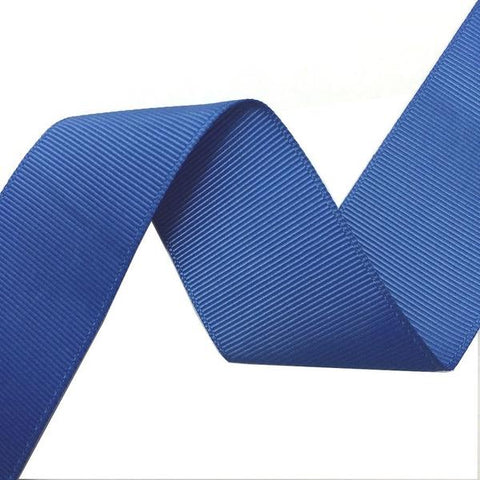
A plain weave, tight, corded fabric featuring heavy, round filling ribs created by a heavier weft and coarse filling yarns. Due to its firm, tight-woven structure, grosgrain is firm but has a dull finish. Grosgrain is generally produced as black but can also come in a wide range of colors and patterns.
Grosgrain is commonly made from wool or silk but can also be made from a blend of fibers such as silk and mohair or wool and silk.
Grosgrain is the preferred fabric for making hems in T-shirts, polo shirts, and underwear, often in elasticized form. Grosgrain ribbon is also used to decorate clothing such as evening wear and fashion accessories like hats because its dull finish makes it less flashy than shiny fabrics such as satin.
Gossamer:
Veiling which is soft and similar to gauze. Gossamer was originally made of silk.
Grosgrain:
A warp-faced, firmly woven fabric. It has distinctive round ribs. Grosgrain is commonly found as a ribbon, but it is also available as full width fabric.
Grospoint:
Fabric with distinctive yarn points on the surface. Grospoint is similar to epinglé.
H
Hatchi

A lightweight, sweater knit fabric that has a characteristic lightly brushed face. Hatchi is actually the brand name of the manufacturer of the fabric, and it is mostly made from blends of cotton and polyester or 100 percent polyester.
Hatchi is available in solids, stripes, and multicolored prints and is suitable for making sweaters, cardigans, and tops.
Homespun
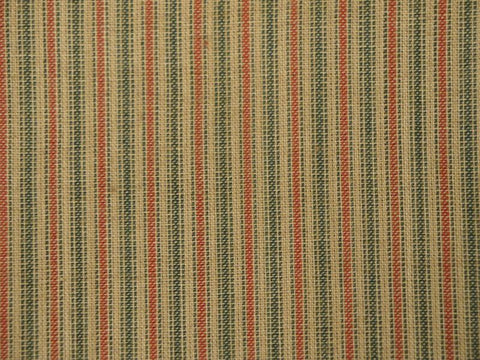
A coarse, plain weave fabric designed to have a hand-woven look. Homespun is primarily made from cotton, and the weaving technique mimics the style used by primitive women to weave their fabrics at home, which is why it’s called homespun.
Homespun is deliberately designed to have slight imperfections, like the homespun fabrics of yore, which is why you may find color variations and nubs in the fabric. Homespun fabric characteristically has no back or front as the designs are made by the color of the thread. Homespun fabric is available in solids, plaid, or stripes. The fabric is great for rag stitching, and quilt works.
I
Interlock Knit
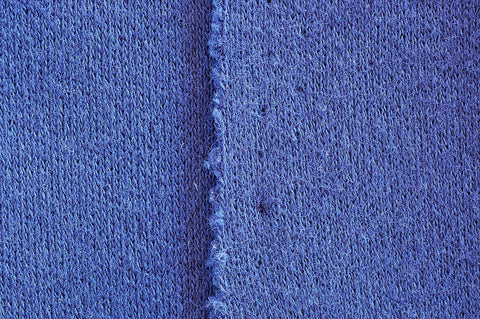
A thick, double-knit, stretchy fabric similar to jersey but which has no back or front sides. Interlock knit has less stretch than jersey and features a soft and cool feel. It has a cool spring-like color and is ideal for making t-shirts, skirts, dresses, and children clothing such as newborn layettes.
ITY Knit
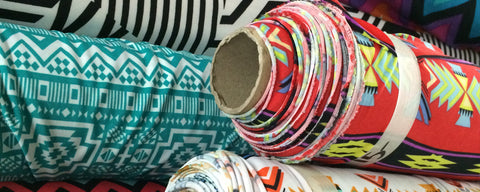
ITY is an abbreviation of Interlocking Twist Yarn, which is a method of twisting yarn in knit fabrics to create a soft feel and more natural elasticity through the material.
ITY is a soft, lightweight, springy jersey knit fabric featuring a flowy drape and a smooth finish. It is highly wrinkle-resistant and primarily made from a blend of polyester and lycra or spandex.
ITY fabric is available in solids and a variety of prints. It is suitable for making flowy pants, tops, skirts, and dresses.
J

A type of woven fabric which is constructed using a special loom that controls the yarns to create reversed patterns on the back of the textile. Jacquard may refer to a diverse array of fabrics made using the Jacquard loom which was invented in 1804 by Joseph Marie Jacquard.
The Jacquard machine simplified the process of making complex fabrics such as damask and brocade, which are two of the most popular jacquard textiles. The process is also used in the production of home decor fabrics, as well as upholstery tapestry fabrics.
Jersey Knit

A light-weight, stretchy, and often thin knit fabric which was traditionally made of wool but is now also made from cotton and synthetic fibers such as lycra, spandex, or elastin. The degree of stretch and drape depends on the use of the fabric and the type of fiber used to make the material.
Jersey can be a single knit, which is usually lightweight and used for making t-shirts, or a double knit as in interlocking jersey which is heavier. It is excellent for making draped clothing such as women's tops and dresses. The fabric got its name from Jersey, Channel Islands, where it was first made.
K
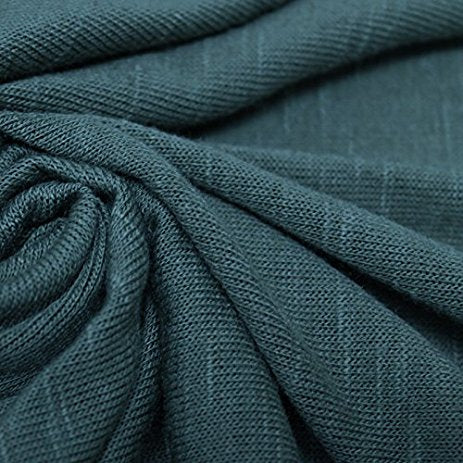
Knit fabric refers to any fabric made from only one set of yarns, all running in the same direction. There are different types of knitting with some having their yarns running along the length of the textile (wales) while some have their yarns running across the fabric's width (courses).
Knitting does not require weaving the yarns and is more durable and flexible than woven fabric. The method creates distinctive ridges in the resulting textile. Knit fabrics can be used multiple times due to their durability. Fabrics such as jersey and ITY are knit fabrics.
L
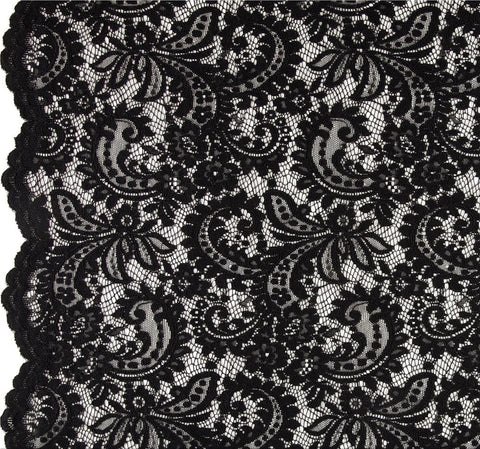
A delicate, open-weave fabric consisting of yarns twisted in a web-like structure to create complex patterns or figures. Lace is traditionally made with linen, silk, gold or silver threads, but is now mostly made using cotton threads. However, you can also find lace made with silk threads and even synthetics.
Lace is made either by hand or machine and could be created with techniques such as knitting, knotting, crocheting, and weaving. There is a wide variety of laces including the needle, bobbin, Chantilly, tape, knotted, knitted, chemical, and filet laces among others.
Lace is used for a wide range of purposes including bridal and evening wears, home decor, party decor, table runners, and others.

A lustrous knit or woven fabric featuring thin ribbons of metallic fiber. The fabric is often made with flat gold or silver metal threads to create a background or design in the textile, which gives the fabric its characteristic gold or silver color. There are different types of lame including the pearly, hologram, and tissue lame fabrics.
Lame is mostly used for constructing dresses and evening wears as well as dance and theatrical costumes. Lame is not suitable for everyday attire as it tends to slip at the yarn and seams.
Laminate
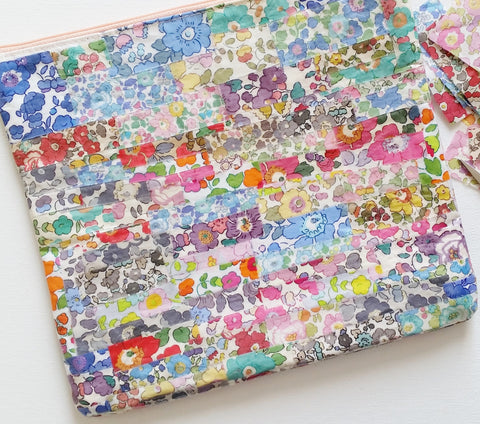
A fabric made by bonding a polymer film to a piece of fabric, which is often cotton. Laminated fabric is excellent for making rainwear, linings, automotive interiors, and table coverings among others.
Faux Leather ( Vinyl )
A Simulated leather.
Linen

A fabric made from the fiber of the flax plant, featuring a rustic weave and crisp texture. Due to its breathability and absorbance, linen is an excellent textile for making summer and spring attires as it provides coolness and a refreshing comfort in the hot, humid weather.
Linen is a versatile fabric that can be used for men and women's wear, towels, bags, aprons, bed linens, chair covers, napkins, tablecloths, and runners. Perhaps, linen is one of the oldest fabrics in the world as archaeological records show it's been used by humans for over 36,000 years.
Lawn
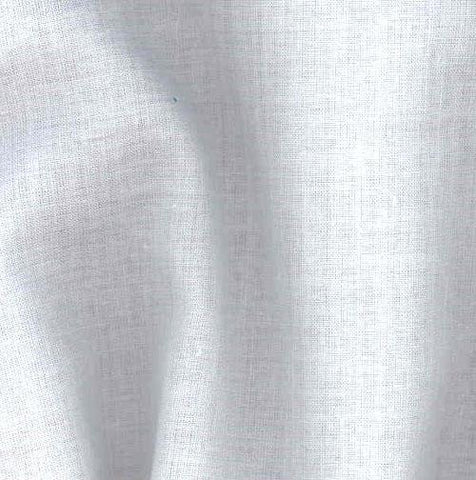
A lightweight, plain weave fabric made with combed or carded cotton or linen yarns. The fabric features a crisp, crease-resistant finish and a semi-transparent texture which can range from sheer to completely opaque. Lawn features varying degrees of crispiness but is never stiff. The fabric may be white, dyed, or printed.
Lawn is mostly used for women's wear such as blouses, dresses, nightwear, lingerie, and underwear. It is also used for shirting, collar cuffs, curtains, handkerchiefs, infant wear, as well as liturgical vestments like the rochet and surplice.
M
Madras

A lightweight, mostly cotton textile that features a distinctive patterned texture and plaid design.
Named after the city of Madras, India, which is now known as Chennai, madras fabric is mostly used for making men and women's summer clothing such as pants, jackets, dresses, and shorts. The fabric is available in regular plaid patterns, seersucker, and patchwork.
Matelassé

A medium to heavyweight luxury fabric made using a stitching or weaving technique that produces a quilted or padded pattern on the surface. Matelassé is a method which is designed to simulate hand-stitched quilts from the French city of Marseilles.
While the textile has a thick and heavy texture that makes it look padded, it has no padding whatsoever. The fabric can be made by hand, on a quilting machine or a jacquard loom. It is commonly used to make evening dresses, draperies, and upholstery.
Melton

A dense, heavy, twill weave fabric that was traditionally made from tightly woven wool or wool blend. The fabric is highly compacted, which gives it a characteristic smooth surface resembling felt. Due to its heavy and hardy texture, Melton hardly frays, and it is extremely tolerant of weather elements.
Melton originated from the small town of Melton Mowbray in Leicestershire, which is where it got its name. The fabric is mainly used for heavy outer garments, coats, and blankets due to its felt-like attributes which make it weather resistant.
Mesh

A loose woven or knit fabric characterized by a net-like structure of closely spaced holes. Knit mesh is commonly used for sports jerseys and other apparels. It is also used for making nets for windows and mosquito nets.

A cuddly and fuzzy polyester fabric designed to mimic the look and feel of the mink's fur. Minky is similar to fleece, but is thicker and softer and provides warmth and comfort. Minky fabric is available in a variety of colors, patterns, and designs.
It is the preferred fabric for making comfy baby products such as baby blankets, baby clothing, baby accessories, stuffed toys, among others.
Monk's Cloth

A heavyweight, even-weave cotton fabric that utilizes the 4x4 basket weave. It is widely used in Swedish weaving and a host of other weaving projects. Made from 100 percent cotton, monk's cloth has poor dimensional stability which causes it to snag after washing.
It’s advisable to wash it before using the fabric to achieve the correct sizing. Monk's cloth is used for draperies, decorative items such as slipcovers and others.

A light to medium weight plain weave, low count cotton sheeting fabric. Muslin is generally inexpensive and can have weights ranging from extra sheer to coarse. Muslin is thought to have originated from the old Iraqi city of Mosul from where it got its name.
Muslin is commonly used in the dressmaking industry to test the fit of a garment before using the actual fabric, helping to prevent costly mistakes that could damage expensive textile materials and put the tailor in serious trouble. It is also used as a lining or backing for quilts. Muslin can also be used as a filter in the culinary industry and its the preferred textile for making theatre sets and photography backdrops.
N
Netting

Netting, also known as net refers to any fabric with an open-construction which results in a material with open spaces between the yarns. Netting can be made by weaving, knitting, knotting, or looping.
Netting is used in a wide range of industries. It may be added to other fabrics to make clothing. Netting is also used for making fishing nets, medical gauze, camping nets, and luggage bags, among others. Net can be made from natural and synthetic fibers.
Nylon
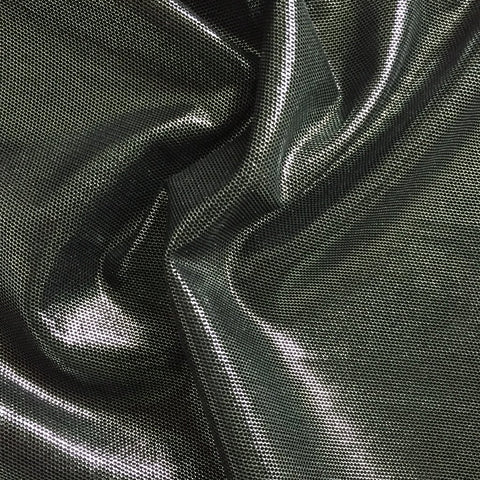
Nylon is the general term for a group of synthetic fibers. First produced in 1935, nylon is the first 100 percent synthetic fiber and also the first commercially successful synthetic polymer of thermoplastic origin. The material is strong and extremely resilient.
Nylon has a wide range of uses, including fabrics.
O
Oilcloth
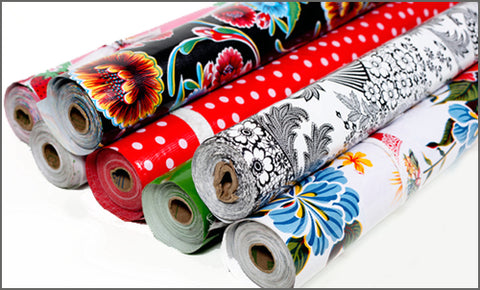
A close weave, linen or cotton duck fabric printed, bleached, or dyed and treated with linseed oil and pigment preparation to make it waterproof. Oilcloth was used in the past as a substitute for leather as it was much cheaper than the latter.
Oilcloth is commonly used to make brightly colored tablecloths and waterproof outerwear, but vinyl and plastic-coated fabrics have now replaced it.
Onion Skin

A lightweight knit fabric printed on the right side with a subtle pattern at the back similar to the onion skin.
Onion skin fabric is semi-sheer and has a crosswise stretch. The material is easy to use and low maintenance.
Onion skin fabric is used for making patterns in woven fabrics. It is perfect for shirts, skirts, tops, ponchos, capes, and scarves.
Organdy

A stiffened, sheer, lightweight plain-woven fabric made from cotton or polyester. Organdy is the crispiest and sheerest cotton fabric featuring combed yarns and its wrinkles quickly due to its fiber content and stiffness.
Organdy is great for summer wear, draped clothing, loose clothing, dresses, and curtains.

A thin, crisp, sheer, lightweight, plain weave fabric featuring a medium to high yarn count. Traditionally, organza was made from silk, but most modern organza fabrics are made using synthetic fibers such as nylon, rayon, or polyester.
Organza is excellent for special occasion garments and lightweight interfacing fabrics. It’s perfect for bridal wear, eveningwear, interior decorations, among others.
Osnaburg
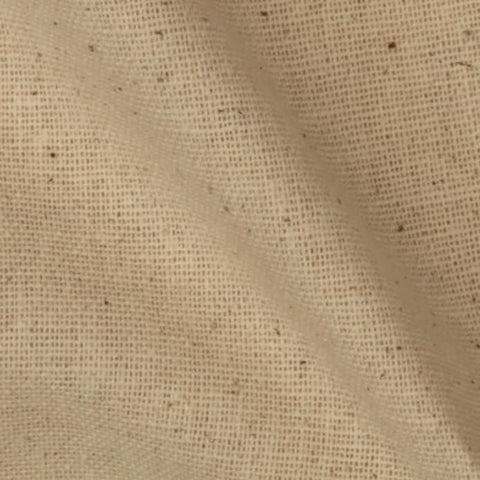
A lightweight, crisp, sheer, plain weave fabric. It was formally the name of a type of plain fabric with a coarse texture. Osnaburg is made from woven cotton, and the strong and durable fabric is ideal for making draperies, apparel, upholstery, and others. It can also be used for costumes and craft projects.
Osnaburg is coarse and can be printed, painted, or dyed to different colors.
Ottoman
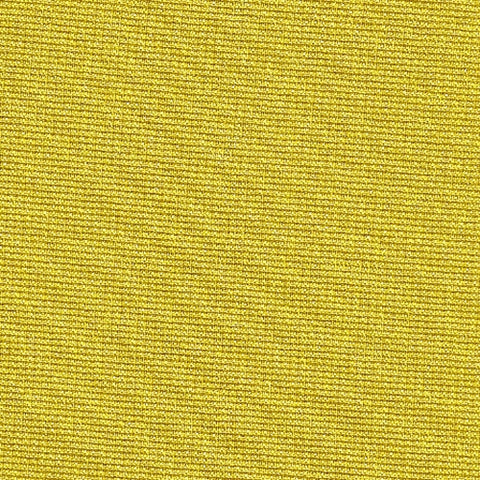
A heavy, plain weave fabric featuring wide, flat crosswise ribs that are higher and larger than in faille. Ottoman can sometimes have alternating narrow and wide ribs. An ottoman with narrow ribs is known as Soleil.
Ottoman fabric is made from different fibers. The warp could be made using silk or manufactured fiber while the filling could be cotton, silk or wool or synthetic fiber. Ottoman is perfect for formal dresses and is the preferred fabric for legal and academic dresses, suits, coats, and trimmings.

Outdoor fabric refers to waterproof fabric mostly used to cover surfaces exposed to weather elements. Outdoor fabric is used to cover pillows, cushions, equipment, vehicles, or create awnings, and to protect open spaces from the effects of the elements.
Outdoor fabric is made from polyester or acrylic fibers, and are highly resilient, durable and soil, stain, and water resistant. One great feature of outdoor fabric is the ease of cleaning and low maintenance.
Oxford

A fine, soft, lightweight woven cotton or blend of cotton and synthetic fibers fabric featuring a 2 x1 basket weave variation of the plain weave construction. Oxford is used mainly for dress shirt fabric, especially for making casual and formal clothing such as the popular Oxford shirts.
There are different types of Oxford fabric including the plain Oxford, Royal Oxford, and the Pinpoint Oxford. Each variety is used for different types of shirts, e.g., the plain and pinpoint are used for casuals while the Royal is perfect for formal shirtdresses.
P
Pack Cloth

A sturdy and pliable fabric, usually of nylon. Perfect for utility items like bags and tents.
A durable and pliable fabric often made of nylon. Packcloth is the choice fabric for a variety of outdoor and DIY projects, due to its durability.
Packcloth is ideal for utility items such as bags, tents, and others.
Panné Velvet
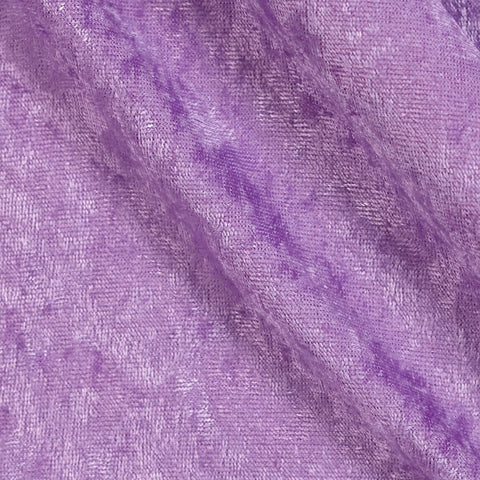
A lightweight, lustrous, velvety fabric featuring pile which has been flattened in one direction. Panne velvet is often stretchy and features a varied sheen and nap.
The fabric is perfect for tops and dresses. Panne velvet is mostly made of silk or rayon.
Pincord

A fabric with an appearance and texture similar to corduroy with fine raised strips. The fabric is commonly used for clothing and home decor projects. It is a durable fabric which is great for shirts, jackets, and trousers.
Peachskin

A soft fabric with a brushed texture which resembles the skin of a peach on one side. Peachskin has a smooth hand and a fluid drape. The surface fuzz that creates the peach-like skin is due to an enzyme treatment that also helps to bulk up the fabric.
Peach skin fabric is mostly used for making blouses, skirts, and dresses among others.
Peau de Soie

A heavy twill, drapeable satin weave fabric made from silk or synthetic fibers. Called paduasoy in English, peau de soie has been around since the 15th century, and the fabric has featured prominently in literature and history.
Peau de soie fabric has a more matte sheen than other satin textiles and is great for clothing, home decor, and upholstery among others.
Piqué

A weaving or knitting technique that produces a medium-weight fabric with a pebbly texture that resembles a check. Pique fabric is available in different forms and ranges from the heavyweight waffle cloth, cord, honeycomb, to semi-sheer dimity fabric.
Pique fabric is made from cotton, silk, and cotton-silk blends. The fabric is suitable for a variety of clothing uses.
Plissé

A lightweight, plain-woven, fabric featuring a characteristic puckered striped effect which is the result of a caustic soda treatment, mostly in the warp direction. Plisse is made from cotton or manufactured fibers such as rayon or acetate.
Plisse looks like seersucker fabric and is used for dresses, shirting, bedspreads, and pajamas.
Pointelle
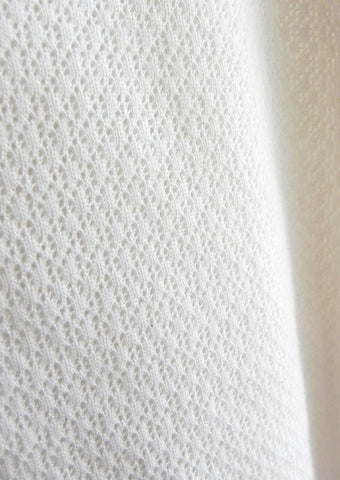
A lightweight, feminine, delicate, rib-knit cotton fabric featuring a geometric pattern of openings. Pointelle is commonly used for making childrenswear, T-shirts, and pajamas.
Poplin
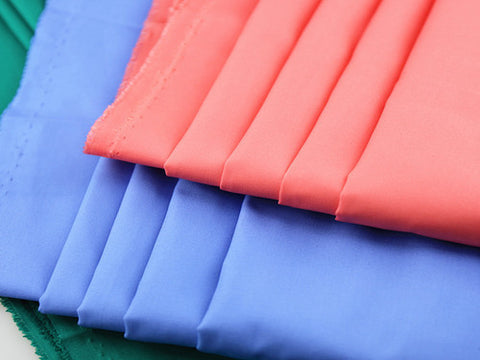
A sturdy, plain weave, fabric featuring crosswise ribs resulting in a corded surface. Poplin was traditionally made of silk but is now also made from cotton, wool, rayon, and polyester or a blend of fibers.
Poplin was formerly used for casual clothing but is now being used for making men and women's attire and upholstery work. Poplin was named for the papal residence in 15th century Avignon, France.
Q
Double Sided Quilted Cotton

A method of making fabric in which a layer of fiberfill or down is placed between two layers of fabric which are held in place by sealing or stitching in a regular, consistent, all over pattern on the textile.
The fabric may consist of two layers of cotton with a polyester filling. Double-sided quilted cotton features the beautiful quilted appearance and can be used for jackets, handbags, placemats, among others. The fabric comes in a wide range of prints and colors.
R
Rib Knit

A pattern in knitting in which vertical stripes of stockinet stitches alternate with vertical stripes of reverse stockinet stitches. This type of knitting has higher stretch across the grain and is notated using the number of knit stitches multiplied by the number of purl stitches.
Rib knitting is mostly used for edges that need to be form-fitting such as sweater hems and cuffs.
Rip-Stop Nylon
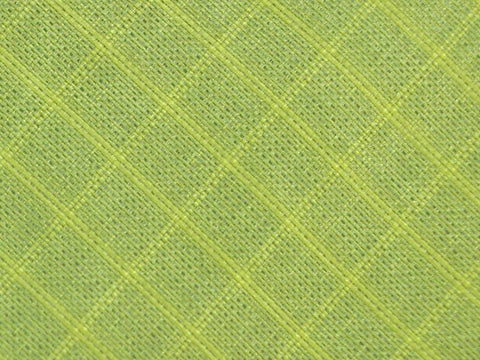
A lightweight, wind, and water-resistant fabric made using a specialized technique which produces a rip-resistant fabric. As the name implies, Ripstop nylon is made from nylon, but can also be made with cotton, silk, and polyester.
Ripstop nylon is commonly used for outdoor wear, high-quality camping gear such as tents, sleeping bags, and camping hammocks. The fabric is also used for making banners, flags, kites, parachutes, yacht sails, and covering for equipment.
S
Sailcloth

Any heavy, weave canvas fabric that is used for making sails or apparel. Sailcloth can be made with natural fibers such as cotton, jute, silk, or flax and synthetic fibers such as aramids, polyester, carbon fibers, or nylon.
Sailcloth can come in the form of molded, spun, or woven fabric.
Sateen

A fabric made from spun yarns of low luster using the satin weave.
A fabric made from yarns with low luster, such as cotton or other staple length fibers. The fabric has a soft, smooth hand and a gentle, subtle luster. Sateen fabrics are often used for draperies and upholstery.
Sateen fabric has a soft, smooth hand and a glossy finish. Sateen was traditionally made from cotton, but rayon is also used to make the textile in modern time. The fabric is perfect for draperies and upholstery.
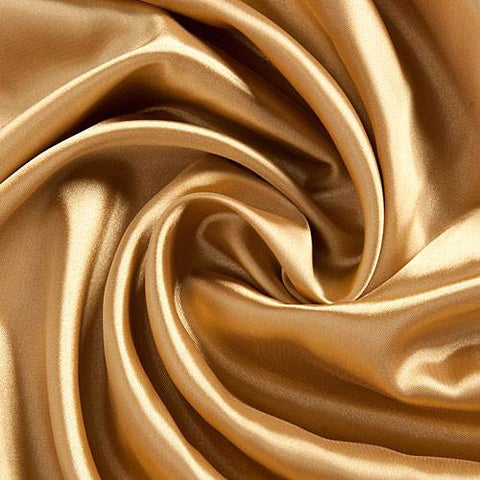
A type of weave that produces a textile with a lustrous surface and dull back. Satin fabric’s drapeability depends on the fiber content. Satin fabric made of silk and rayon is one of the best on the market. They are mostly used for draperies and upholstery.
With a lustrous, shiny surface, drapability depends on fiber content. Silk and rayon satins have the best stitch results.
Seersucker
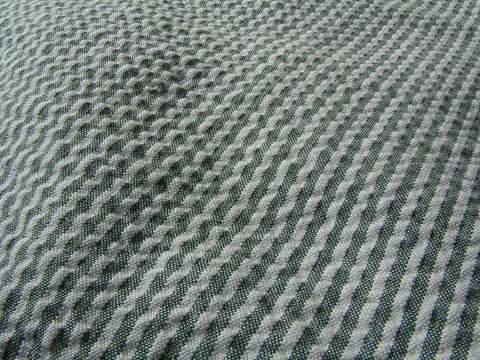
A thin, woven, puckered fabric mostly made from cotton with a checkered or striped pattern. The weave in a seersucker bunches up threads, resulting in a wrinkled appearance in some areas of the fabric. This feature makes the fabric to leave some space between itself and the skin when worn, increasing air circulation and heat dissipation.
Seersucker is mostly used for summer and spring clothing. It is ideal for making suits, shirts, dresses, shorts, casual slacks, childrenswear, robes, and curtains.
Shantung
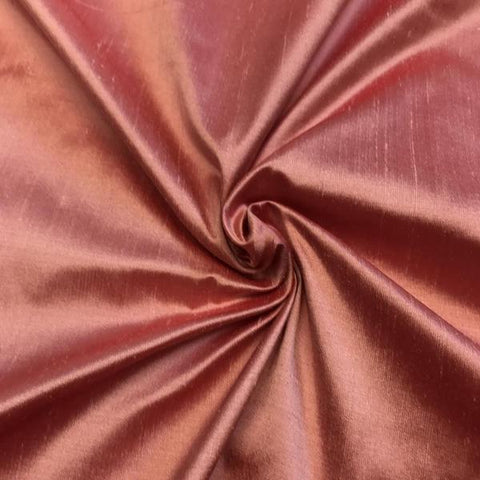
A silk fabric similar to Dupioni but with a thinner and more refined appearance. Shantung originated from the province of Shandong in China.
Shantung is mostly used for bridal gowns, tailored pants, and fuller skirts.
Faux Suede

A soft, synthetic fiber with a matte finish made to mimic the look of regular suede.
Faux suede is made from 100 percent polyester. The fabric is used extensively in the fashion industry for making jackets, skirts, pants, among others. Faux suede is also used in home decor for sofas, throw pillows, decorative curtains, and loveseats.
T
Taffeta
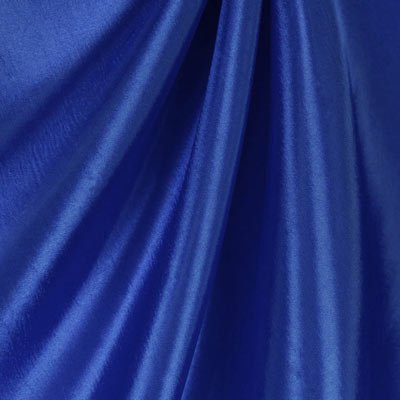
A plain woven, crisp, smooth fabric made from silk or rayon. Taffeta has Persian origins, and the fabric is a luxury textile mostly used for wedding dresses, ball gowns, curtains, and wallcoverings. It is also used for making corsets and affiliated products.
Tapestry

A heavy, ribbed, often hand-woven fabric that features an elaborate design depicting a historical or current pictorial display. In tapestry, the weft-faced fabric design is made with colored filling yarns only in the areas where details are needed.
Tapestries are a form of textile arts and have been in use since medieval times. It is mostly made from natural fibers such as cotton, wool, and linen. Tapestry is used for making detailed wall hangings and upholstery.
Tarpaulin:
Waterproof, heavy canvas-like fabric or the covers made from such fabric. Tarpaulin is often made of nylon or other synthetic fiber.
Terry Cloth

A knitted or woven fabric with loops that are highly absorbent. There are two types of terry cloth including the 100 percent cotton terry towel with long loop piles that are highly absorbent and the cotton or fiber blend French terry used for making childrenswear, and men's and women's clothing.
Terrycloth is commonly used for making diapers, reusable nappies, towels, bed linen, bathrobes, and sweatbands for the head or wrist.

An extremely fine, lightweight, machine-made fabric with a softer texture than netting. Named after the city of Tulle, France, where the fabric was first made, tulle can be made from a variety of natural and manufactured fibers such as cotton, silk, rayon or nylon.
Tulle is mostly used for bridal veils, evening gowns, lingerie, floral arrangements, costumes, hats, and window treatments.
Tweed
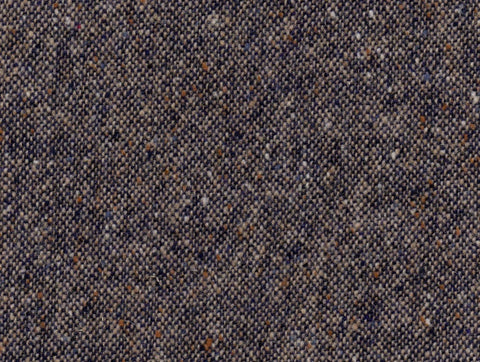
A coarse, plain or twill weave, medium to heavyweight, soft, woolen fabric featuring colored slubbed yarns.
A highly durable and moisture-resistant fabric, tweed is the mainstay of traditional Irish and Scottish attire and is designed to be worn for outdoor activities such as hunting and shooting.
Tweed is commonly used for suits, coats, and other harsh weather clothing.
Twill
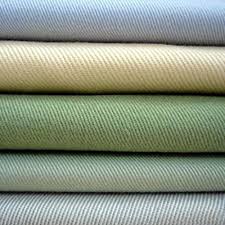
A type of fabric weave that features a distinct pattern of diagonal parallel ribs and excellent drapery qualities. The twill weave is used for several fabrics including denim and gabardine.
U
V
Velour
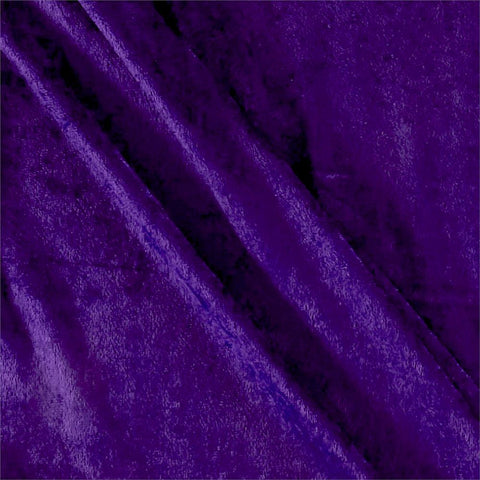
A velvety, knitted or woven, stretchy fabric mostly made from cotton but which can also be made from manufactured materials such as polyester.
Velour is perfect for clothing such as tops, pants, jackets, sportswear, dancewear, and upholstery like car seats and leotards.
Velvet
With a longer pile, velvet is the most luxurious fabric. Appropriate for tops, skirts and fuller pants, and home decor upholstery.
Velveteen
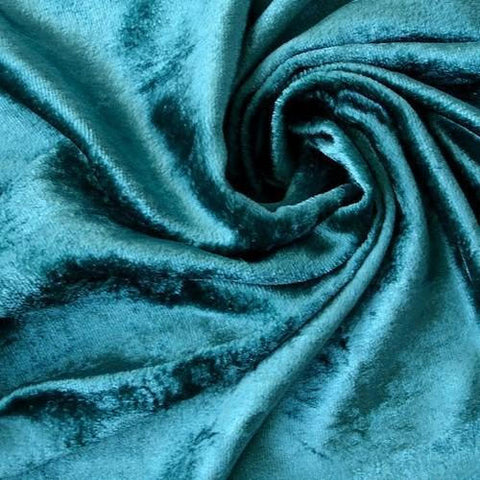
A fabric made to imitate the appearance of velvet, often made from cotton but can also be made from a blend of cotton and silk. Velveteen has a short, dense pile, and lacks the drape and luster of velvet.
Velveteen is used for clothing such as skirts, jackets, and pants as well as home decor items and drapes.
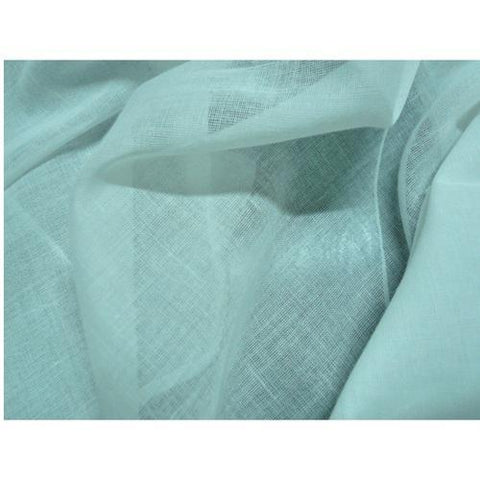
A crisp, lightweight, soft, sheer, plain weave fabric made mostly of 100 percent cotton or a blend of cotton and linen or cotton and polyester.
Voile is similar to organza and organdy in appearance and used for dressmaking, curtains, and others.
W
Waffle Cloth
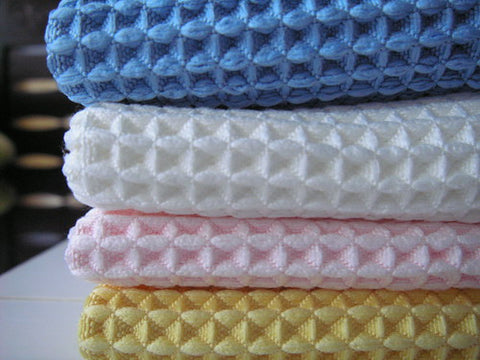
An absorbent cotton or microfiber fabric similar to pique in texture. Waffle cloth sometimes has a honeycomb weave made on a dobby loom and comes in a variety of weights.
Waffle fabric is commonly used for cleaning surfaces in the industry due to its high affinity for moisture.
Waverly Fabrics:
One of the world's top manufacturer's of premier interior decorating fabrics used for upholstery, drapery, and wall covering. Waverly was founded in 1923 by F. Schumacher & Co., a leading maker of European fabrics, to provide American consumers with high quality interior design fabrics. The company soon expanded, providing wallcoverings and furniture as well as fabric. Today, Waverly fabrics are licensed by P. Kaufmann and continues to provide classic, quality upholstery and drapery fabrics.
Wedding Tulling:
Tulle or netting fabric used to decorate weddings and also used in wedding garments. Wedding tulling is available in every color imaginable on economical forty yard and fifty yard bolts. It is used to elegantly drape the ceiling of the reception area and around and on reception tables. It is available in ribbon widths used to make large bows for pews and chairs. Tulle is also used to make layered underskirts or petticoats which make full skirts stand out. This delicate sheer fabric makes great overskirts for full skirted wedding dresses and bridesmaid dresses.
Wool Crepe
A lightweight worsted fabric having a crinkly appearance which is derived by using warp yarns that are twisted tightly in alternate directions.
Wool crepe also refers to a lightweight worsted fabric with either a little or no crepe surface used for women's wear.
Woven Fabric

Any fabric formed by weaving. Woven fabrics are composed of two sets of yarns including the warp which runs along the length of the fabric and the weft which run perpendicular to the warp.
Woven fabrics are held together by interlacing the warps and weft at right angles to one another. Woven fabrics are mostly created on a loom.
X
Y
Yarn
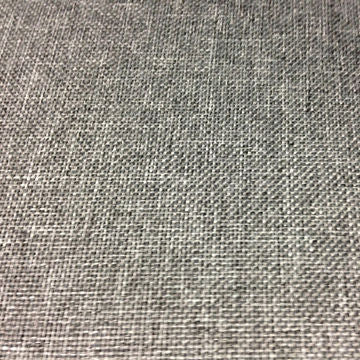
A long continuous strand of textile fibers formed when a cluster of individual fibers is twisted together. Yarn is used for making textiles, sewing, weaving, knitting, crocheting, embroidery, and ropemaking. Yarn can be made from natural and synthetic fibers.
Yarn-Dyed
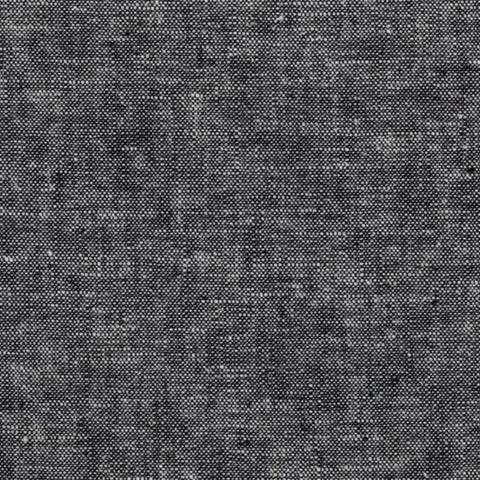
A continuous strand of textile fibers created when a cluster of individual fibers are twisted together. These long yarns are used to create fabrics, either by knitting or weaving.
A yarn dyed with natural or artificial colors.
Z
Zari
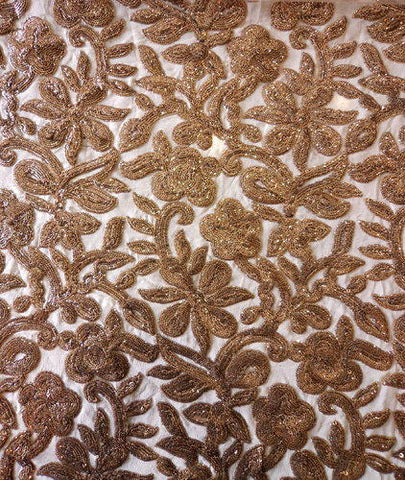
An even thread formerly made of fine gold or silver to add a metallic sheen to fabrics such as brocades.
Zari is mostly made of silk woven into fabrics to form detailed patterns. Zari is commonly used in Indian and Pakistani traditional clothing such as saris and gharara and also used in other silk garments like skirts and tops.











